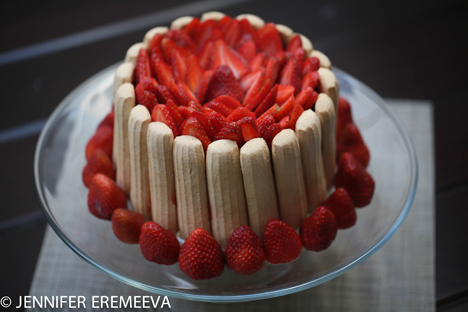
Valentine’s Day is coming up and there is no better way to say “I love you” than by separating some eggs and sifting some dry ingredients to make a romantic dessert. Charlotte Russe was a no-brainer for me this year: the perfect end to an aphrodisiac food extravaganza: it’s light but oh-so rich, it looks spectacular, and it contains strawberries. I can’t contemplate Valentine’s Day without strawberries, can you?
Charlotte Russe is very easy to make – don’t let appearances deceive you. The important thing to note, however, is that it does need to be thoroughly chilled before serving. To play it safe, I suggest you chill it overnight.
Ingredients
25 sponge cake “ladyfingers” and 2 sponge cakes cut to fit the inside of the finger-lined mould or more ladyfingers
2 Tbsp unflavored gelatin
2 cups of whole milk
6 eggs, separated
½-tsp of salt
2 cups of heavy cream
2 Tbsp of confectioners’ sugar
2 tsp of vanilla divided into two equal portions
1 jar of best quality raspberry jam
3 Tbsp of rum
4 cups of hulled strawberries, sliced into 1/8-inch slices
Charlotte Russe is part of the Beef Stroganoff/Veal Orloff/Salat Olivier family of dishes – a French import that has become quintessentially Russian. A charlotte, named in honor of Queen Charlotte, the wife of the British King George III was a popular version of the trifle in 18th Century Europe, consisting of thick fruit puree baked in a special mould lined with buttered bread. This form of trifle was very common throughout Europe at the time, and varied only in the ingredients used for the puree.
The confusion between the Russian apple cake called "Charlotka" and the moulded Charlotte Russe is common, but "Charlotte Russe" is just "charlotka's chic french cousin. In Russia, Alexander I’s French chef Marie-Antoine Carême put an icy touch on it, inspired, no doubt by the long Russian winters. Carême lined his charlotte mould with sponge cake “fingers” and layered more sponge cake in between layers of Bavarian cream or mousse.
What both dishes have in common is the mould pan called a "charlotte" in which they are prepared, which can be used in preparation for either.
The hardcore domestic goddess types would now go into a long lecture about how much better it is if you make your own sponge cake. Not this domestic goddess. I’m all for buying the sponge cake, or using ladyfinger cookies, which were invented for just this purpose.
Charlotte Russe is that rare baking opportunity that affords the cook a little room to be creative. There are almost no hard and fast rules about flavor or color, so feel free to experiment. You can soak the ladyfingers or sponge in liqueur/syrup such as raspberry cordial or Grand Marnier. You can also top the charlotte with fruit or candy. Since this is Valentine’s Day, I’m sticking to pink and red, and of course, using strawberries to top the dish.
Instructions:
Priyatnogo Appetita!
Jennifer Eremeeva is an American author based in Moscow. She is the author of Lenin Lives Next Door: Marriage, Martinis and Mayhem in Moscow, available from many online retailers. To find out more about Jennifer, visit jennifereremeeva.com.
Note: here is the best link for the book if online.
All rights reserved by Rossiyskaya Gazeta.
Subscribe
to our newsletter!
Get the week's best stories straight to your inbox